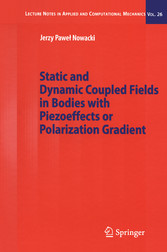Suchen und Finden
Mehr zum Inhalt

Static and Dynamic Coupled Fields in Bodies with Piezoeffects or Polarization Gradient
"7 GREENS FUNCTIONS FOR PIEZOELECTRIC STRIP WITH A GENERAL LINE SOURCE (p. 125-126)
In this chapter we are going to derive the static Green function describing the 2D coupled fields in arbitrary piezoelectric strip excited by a general line defect parallel to the surfaces and consisting of the four line sources introduced in Sec. 3.3 (c): the line of forces f, the line of charge q, the straight dislocation with the Burgers vector b, and its electrostatic analog of the strength A(p. As we have seen in Ch. 3, the latter line defect is completely determined by the discontinuity Aip in the electrical potential across the arbitrary plane cut ending on the line, which in our case determines the coinciding positions of all the mentioned sources.
The first studies in this field were accomplished for a particular case of straight dislocations in isotropic elastic plates [55-59]. These results were later extended for anisotropic [53] and possibly inhomogeneous [54] purely elastic (nonpiezoelectric) infinite strips. The further extension of the theory for the case of arbitrary piezoelectric strips has been developed in our paper [28]. The content of Chapter 7 is based on this paper.
7.1 Statement of the problem and basic equations
(a) Some preliminary remarks
The aim of this chapter is a derivation of the electro-elastic fields excited in a piezoelectric plate by the general line defect defined above. Of course, such an object, as the general line defect first introduced by Lothe & Barnett [63], is only conventionally a "defect", because among its four constituent line sources there is only one lattice defect - the dislocation. So, perhaps, it would be more correct to talk about the general line source rather than about a defect.
Anyway, independently of the terminology introduced and accepted before us, below we are going to find the physical fields excited by such a combined source. In our analysis it will be convenient to follow the method developed in [54] for purely elastic anisotropic continuously layered media, specifying the problem to a homogeneous medium and simultaneously extending it for a piezoelectric case. Such an extension turns out to be not quite straightforward because of the electrical boundary conditions, which are determined by a continuity of the normal component of electric displacement on the interfaces between the strip and the adjoined isotropic dielectric media. Our consideration will be based on the Stroh-like approach presented in details in Chapter 3 (Sec. 3.3 (c)) where the problem was already formulated for the same general line defect in unbounded medium."
Alle Preise verstehen sich inklusive der gesetzlichen MwSt.








